MJM has acquired several ancient deeds and local legal instruments dating back to the early days of the settlement of Bermuda. Andrew Martin examines the legal context of these documents and their relevance in the development of legal principle, and puts them in their social and historical context.
The second original document in our series involves one Perient Trott, a character of some importance and notoriety in Bermuda's early settlement and economic development.
Perient Trott was the eldest son born to a silk merchant in London 400 years ago, probably in 1614. He became a highly successful tobacco merchant in the 1650s to 1670s and made a substantial contribution to the development of independent commerce in Bermuda. Trott made a lot of money trading in Bermuda tobacco, but as the largest single owner of shares in the Somers Islands Company, he also made some very powerful enemies, who set out to ruin him.
The direct result of Trott's 20 year legal battle with the Earl of Warwick's family was the collapse of the Somers Islands Company and the establishment of the direct colonial rule of Bermuda from Britain in 1684.
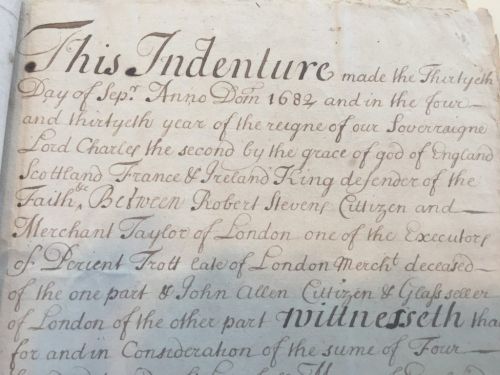
The Deeds
This intriguing pair of deeds relates to (i) the sale and transfer of four shares (100 acres) of Bermuda land initially sold by the executors of Perient Trott's estate to one John Allen, a glass seller (and member of the Honourable Company of Glass Sellers), of London in 1682, for £400, and then (ii) the re-purchase of those shares back from John Allen by the (then sole remaining) executor, one Robert Stevens (Merchant Taylor) of London, in 1686, for the same price of £400, plus 5 shillings, in consideration of the performance of a certain undisclosed 'trust'.
For reasons unknown, both of these transactions had to be authenticated many years after their execution by a Declaration dated 20 November 1712. One of Perient Trott's sons, John, verified the authenticity of the signature of Samuel Nash, who was one of the witnesses to the Deed of Sale 'in trust' to John Allen in 1682. He also verified the authenticity of the signature of Nicholas Trott (probably his uncle, but possibly his brother), who was one of the witnesses to the deed of repurchase in 1686. John Trott declared on oath that he was "very well and was perfectly acquainted with" the handwriting of each of these witnesses and could personally attest to authenticity of their signatures. This attestation is annexed to the two deeds, and although it is in much worse condition that the deeds themselves, the basic thrust of the certificate is clear enough.
Like the first deed in our series, these Deeds are hand written in ink gall. The first deed of sale was executed in the 23rd year of the reign of King Charles II (1682) and the re-transfer deed was executed in the second year of the reign of King James II (1686). Although each one says it is an indenture, there are no formal indentations. It is written on paper, not parchment. The paper is fairly rough early paper, which was made from scraps of cloth, and its texture has the feel of a coarse modern blotting paper.
There is a large red wax seal still intact on the top left corner, but the details of the crest are obscure. It affixes the document, and is not a seal witnessing a signature. There appear to be two figures standing and a shield of crossed sea horses (or something similar?), with a motto beneath the crest, which is illegible.
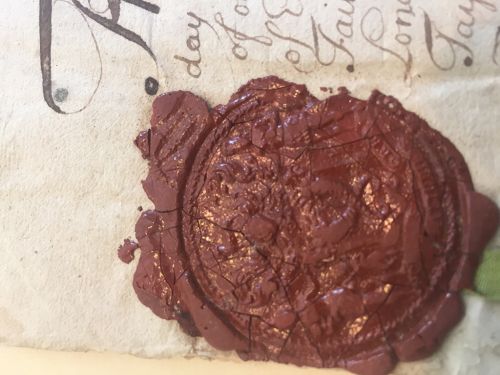
Deeds of transfer of shares were supposed to be validated under the seal of the Company. But this seal is not the crest or seal of the Somers Islands Company; nor does it relate to the Honourable Guild of Merchants Taylor (of whom Stevens was a member); nor to the Honourable Company of Glass Sellers (of whom Allen was a member). The seal might relate to the Notary who drew the document. Or (perhaps more likely) it might relate to the Governor who validated the signatures of the witnesses to the execution of the Deed in 1712.
The authenticity of the Deeds was verified by declaration John Trott before the un-named Governor of a "Province", but because the certificate is quite badly damaged, it is not clear which Province, and having ruled out all the most likely candidates, this detail remains elusive.
The reasons that lie behind this mysterious transaction are difficult to unravel without digging deeply into the lives of the individual characters involved, the turbulent politics of the day, and the scheming machinations of certain Members of the Somers Islands Company. The main action was played out in the Sadlers' Hall and the Armourers' Hall in London, where the Governor and members of the Company met most often, and the Sessions House in St. George's Town in Bermuda, where the local Governor and his Council met to implement the instructions they received from London.
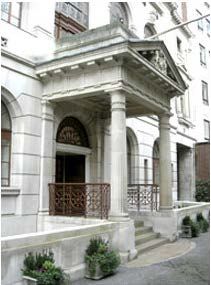
Sadler's Hall, London
The story of the 20 year feud that lies behind the document is long and complicated, and is not easy to summarize in a few lines. I have prepared a potted guide for those who wish to know more. The feud between the shareholders gave rise to disputes over the application of early principles of English company law, land law and public administrative law, also very briefly described.
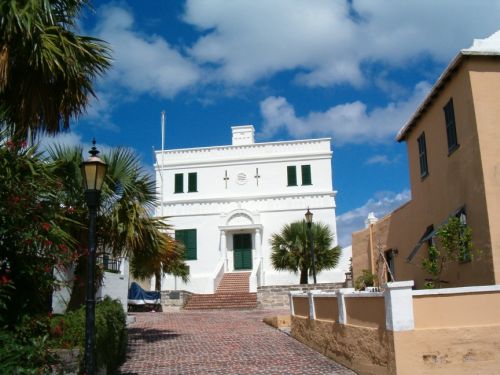
The State House, St. George's
The four shares referred to in the Deeds
The shares sold and repurchased by these related deeds related to two shares of 25 acres each in Devonshire Tribe and two shares also of 25 acres each in Warwick Tribe. By a bit of detective work it was possible to identify where these lands are. They are only generally described in the Deeds, identified by the names of the tenants then in possession. But this is not enough to locate the shares precisely almost 350 years later. A careful examination of the Civil Records for the period and Richard Norwood's Second Survey of 1662/3 gives us sufficient information to do so.
The land in Devonshire Tribe
John Baily
The Somers Islands Company alleged that Trott had failed to pay
duty on his 'illegal' export of tobacco on a ship called
the Four Brothers in 1670, and had 'fined' Trott over
£500, which he refused to pay. So the Company gave orders to
Sir John Heydon, the local Governor, to seize some or all of
Trott's land and goods in Bermuda to collect payment. But
somewhat surprisingly no-one was prepared to admit that they were
one of Trott's tenants, so initially the Company was unable to
collect the fine.
Certain land in Devonshire Tribe had been occupied by a tenant called John Baily (also spelled Bailey). After his death, his widow Susan had been tried and convicted for witchcraft. She had allegedly cast a spell on a man named Holt to 'torment' him (as one does) because he had insisted that she was going to marry a man (Waightman) whom she did not favour, instead of her intended new husband, Robert Cole. Following this heated exchange in a neighbour's parlour, about two weeks later Holt (a tailor) fell prey to such a terrible pain in his shoulder that he could not work. Whereupon Holt accused Widow Baily of witchcraft, and she was charged, tried, convicted, and sentenced to death, but not before marrying Mr Cole.
She was however dramatically reprieved at the gallows, and some time later, but before she was released from jail, she admitted that she and her late (previous) husband had been tenants of Perient Trott. This 'admission' gave Sir John Heydon the basis on which to seize the land in Devonshire Tribe which she and her former husband, and his relatives, occupied.
The land that was occupied by the Bailys comprised two shares in Devonshire Tribe, and these can be identified in the Second Norwood Survey (numbers 4 to 6) and are shown on the map.
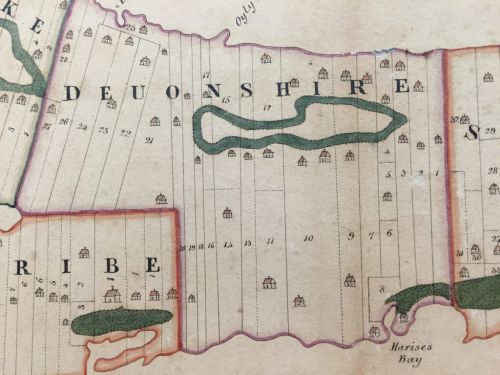
Second Survey by Richard Norwood 1662/3 (map)
These are the very same shares in our Deeds, and can be identified as such by the reference to the neighbour occupying the adjoining shares in the Deeds, also recorded in the Second Norwood Survey, (ie John Long, to the West).
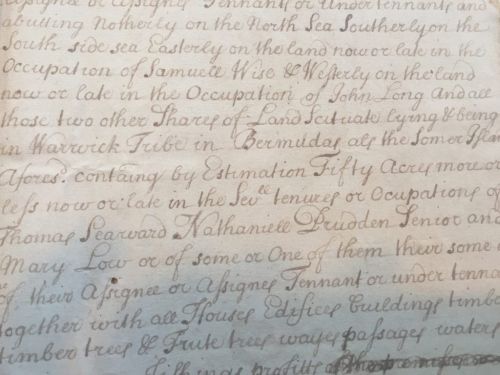
The land runs from approximately the site of the old Clay House Inn on North Shore Devonshire, and across the island southwards almost as far as Devonshire Bay (shown as Harises Bay on the map) on the South Shore (number 8 was Common Land).

An aerial view of the land in Devonshire Tribe
The land in Warwick Tribe
John Bently
John Bently (also spelled Bentley) was the tenant of two shares in
Warwick Tribe, which were purchased by Trott from the 3rd Earl of
Warwick. Bently "turned tenant" and wrongfully paid his
rents to the Earl of Manchester [see
summary], even though it seems very likely that Bently did not
actually occupy any of the land that was claimed. It is possible
that Bently had joined in the revolt against Trott in order to
curry favour with the Earl, or possibly to take advantage of some
opportunism, the precise details of which are now lost to
history.
The result however was that when the Company decided that Bently was in truth Trott's tenant, Trott sought to evict him, not least because he had failed to pay his rent for several years. But in order to frustrate Trott's claims, the local Governor Sir John Heydon, the Warwick family's faithful ally and kinsman, refused Trott's claims to possession. This was part of Sir John's support for the ongoing efforts of the Warwick family to reclaim the lands the 3rd Earl of Warwick had sold to Trott. In addition, Sir John fined Perient Trott's son (and resident agent in Bermuda) Samuel the sum of £6 (along with one of Samuel's mates) for breaking into Bently's house in order to evict him. Later, he ordered Perient Trott to pay to Bently's widow £40 in compensation. Compensation for what is not made clear.
After Bently's death, these shares of land were leased to other tenants, namely Nathaniel Prudden Sr, Thomas Seward, and Mary Low.
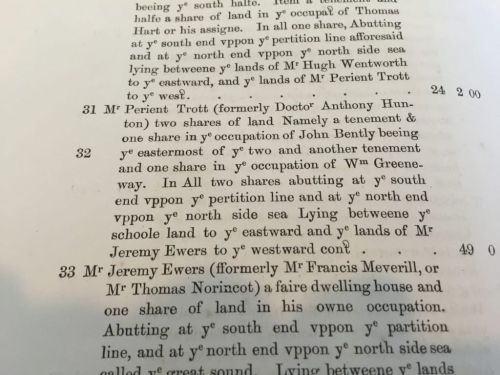
Second Survey by Richard Norwood 1662/3
These shares of land are as shown in the map, and can be pinpointed from the records in the Second Survey by Richard Norwood in 1662/3 (items 31 and 32) showing the occupation by John Bently.
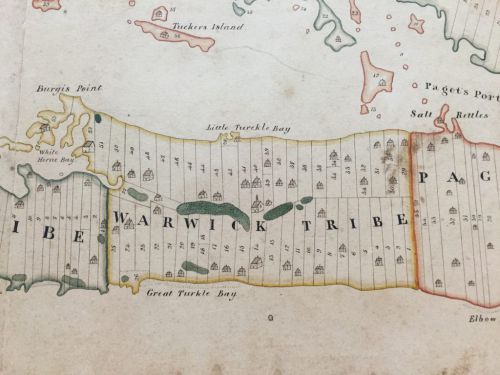
Second Survey by Richard Norwood 1662/3 (map)
These lands run from Harbour Road in Warwick, approximately from Morgans Road to about where the Belmont Ferry stop is today and south across to just beyond Middle Road, including the lands around Keith Hall Road as far as what is now the Belmont Hills Golf Course.
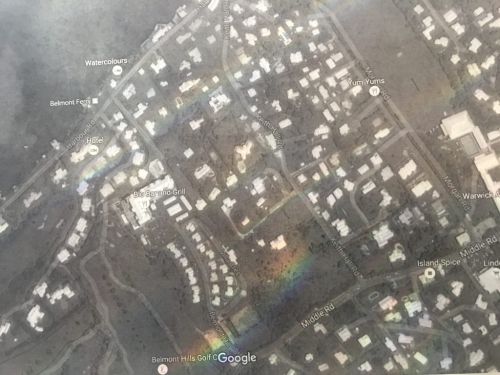
Aerial view of the land in Warwick Tribe
The denouement
Perient Trott died in 1679, at the height of the dispute, aged about 65. The Petition to Parliament which had been launched by Trott and other disaffected shareholders and landowners had not yet been determined.
Presumably Perient Trott's executors felt it was necessary for these four shares of land to be put into 'safe hands'. The nature of the trust is not clear, but the consideration of five shillings is clearly nominal. It was obviously agreed that Allen would hold the land until called upon to sell it back for the same price he bought it for. Both Deeds solemnly recite the price of £400 was paid, and repaid, plus 5 shillings.
The Petition to Parliament, carried on by other landowners and merchants after Trott's death, complained about the injustice and unfair treatment they too had suffered at the hands of the Company, and was ultimately successful. As a result, in the middle of 1684, the Warwick family entered into a private settlement with the executors of Perient Trott's estate, the remaining one of whom was his brother-in-law, the said Robert Stevens. The Warwicks had to return to Trott's estate the 20 shares of land they had illegally seized from him, along with (most of) the rents they had collected on the land in the meantime [see summary].
This would have included these very same four shares. By 1686, the dust must have settled sufficiently for the shares to be recovered from Allen who had been holding them in trust for Trott's estate. Why it was that the execution of these deeds had to be verified thirty years later in 1712 remains a mystery.
But it is hard to square the apparent sale and re-purchase of these 4 shares of land for £400, in trust or not, against the express terms of Perient Trott's Will which instructed his executors and trustees to sell (almost) everything.
The Will provided that except for 3 shares in Hamilton Tribe that were left to his oldest son Samuel (including Walsingham), all of Trott's other property in Bermuda, England and Carolina was be sold and converted to cash to pay all the many cash bequests set out in the Will. These gifts amounted to some £4000 in individual gifts of money, (apart from a few specific bequests of furniture and personal possessions). By a codicil, he also left one share of land in Bermuda to his grandson, Perient. The residue was to be divided amongst his 7 (?) children in equal shares.
Perhaps the (unexpected) recovery of the disputed 20 shares from the Warwick family caused the Trott family to re-think the effect of the Will, and it may be that the sole remaining executor, Trott's brother-in-law, agreed with the family to divide it up rather than to sell it all off. But if this is a plausible speculation, exactly how these landholdings were distributed among the family is now obscure.
What these Deeds reveal is of more than passing interest. For the lawyer, they illustrate the early use of secret trusts, the validation of Deeds 30 years after the event, and the transfer of land for strategic purposes in the complex corporate legal battle between Trott and the Somers Islands Company.
For the historian, the Deeds illustrate the early development of the land holding structure of the plantation settlement, and the emergence of Bermuda as a colonial territory, born of the people who lived and worked on the land, breaking the monopoly of the private company of early 17th century 'adventurers'.
Burnt claret enough for all comers indeed.
The back story
The Legal Issues
The content of this article is intended to provide a general guide to the subject matter. Specialist advice should be sought about your specific circumstances.

